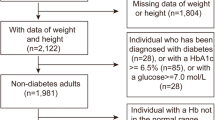Abstract
To investigate the correlation between glycosylated hemoglobin (HbA1C) levels and fasting blood glucose (FBG), 2-hour postprandial blood glucose (PBG2h) and hemoglobin (Hb) levels, and to evaluate the factors influencing HbA1C level as well as the effects of Hb variations on blood glucose and HbA1C levels. 208 patients with type 2 diabetes (T2DM) who resided at an altitude of 1,900 m in Kunming city, China for over 5 years and received oral anti diabetic drugs without adjustments for over 3 months were enrolled. Venous blood was sampled for FBG and PBG2h assays, as well as HbA1C and Hb analyses at three different time points. HbA1C levels were plotted with FBG, PBG2h and Hb levels, and their correlation was evaluated using Pearson’s correlation analysis and regression analysis. The levels of FBG, PBG2h and HbA1C were compared between patients with high and normal Hb levels. There was significant positive linear correlation between HbA1C levels and FBG levels (R2 = 0.87, P < 0.001), as well as PBG2h levels (R2 = 0.89, P < 0.001). The regression equation of HbA1C with FBG (x1) and PBG2h (x2) was y = 1.124 + 0.334x1 + 0.284x2. There was no strong correlation between HbA1C levels and Hb levels. No significant differences were observed in FBG, PBG2h and HbA1C levels between patients with high and normal Hb levels. FBG and PBG2h are the main factors influencing HbA1C levels in patients with T2DM, whereas Hb levels have no significant effects on FBG, PBG2h and HbA1C levels.

Similar content being viewed by others
References
Yang Q, Tong NW. Application issues of glycosylated hemoglobin used to people with hyperglycemia. Intl J Endocrinol Metab. 2011;31:145–7.
Bao YQ, Jia WP. Significance of glycosylated hemoglobin in diagnosis of diabetes. Chin J Endocrinol Metab. 2011;27:367–70.
Monnier L, Lapinski H, Colette C. Contributions of fasting and postprandial plasma glucose increments to the overall diurnal hyperglycemia of type 2 diabetic patients: variations with increasing levels of HbA (1c). Diabetes Care. 2003;26:881–5.
Riddle M, Umpierrez G, Digenio A, et al. Contributions of basal and postprandial hyperglycemia over a wide range of A1c levels before and after treatment intensification in type 2 diabetes. Diabetes Care. 2011;34:2508–14.
Yao YL, Bai XL. Preliminary study on the hemoglobin-HbA1c relation among people with polycythemia in high altitude areas. J High Alt Med. 2006;16:31–2.
Sayarlioglu H, Erkoc R, Dogan E, et al. Nephropathy and retinopathy in type 2 diabetic patients living at moderately high altitude and sea level. Ren Fail. 2005;27:67–71.
Author information
Authors and Affiliations
Corresponding author
Rights and permissions
About this article
Cite this article
Ju, HB., Xu, XM., Shu, ZZ. et al. Blood glucose not hemoglobin influenced glycosylated hemoglobin in type 2 diabetes patients on plateau of China. Int J Diabetes Dev Ctries 35, 197–200 (2015). https://doi.org/10.1007/s13410-014-0225-8
Received:
Accepted:
Published:
Issue Date:
DOI: https://doi.org/10.1007/s13410-014-0225-8




